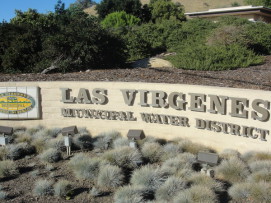News Q&A with Jeff Reinhardt -the Public Affairs and Communications Manager for Las Virgenes Municipal Water District
Las Virgenes Municipal Water District has just hired a new General Manager to fill a vacancy caused by the retirement of the previous GM. Whenever there is a change in an organization’s leadership, it is expected the new executive will bring new and different methods and priorities. So the coming year will be one of transition. However, the District will continue its focus of providing safe and reliable water service along with wastewater treatment services that are protective of public health & safety as well as the sensitive Malibu Creek watershed’s environment.
The water district is engaged in several programs at present. The “Backbone Improvement Program” is a multi-year project to improve the District’s ability to move water across its service area during times of peak demand, or in response to an emergency that might cut off the flow of outside water supplies to the region.
The District is also updating its five-year planning documents that analyze future demands and try to anticipate the infrastructure needed to meet those projections.
In addition, the District is looking to expand its ability to store recycled water. In the winter months, demand for recycled water (used for irrigation) is lower due to rainy weather and cooler temperatures. A new storage facility would allow some of the winter-season water to be saved for the peak demand months of summer.
Finally, the District is always engaged in water conservation education for all age groups. Learning the values of wise water use help preserve natural resources, reduce greenhouse gasses and save natural habitats.
When we conserve water or make better use of recycled water here in Southern California, we put less strain on the water delivery systems that bring water to our region from Northern California, as there are no native sources of drinking water in the LVMWD service area. Being more water efficient in our area reduces the amount of energy needed to transport and treat water and saves water for other purposes.
We don’t believe “drastic” is a term we would use, as water supply, wastewater treatment and water planning are ongoing processes that continually evaluate the region’s needs and weigh them against other factors such as the available supply, the cost of that supply and the ability of the community to support the costs required for the District to perform its services. However, the District must be able to adjust to changing situations, such as a drought, and engage the community in its efforts to deal with such changes.
The District’s total budget for the current Fiscal Year is $61.5 million. The cost for capital (major construction and maintenance) projects for the current budget cycle is forecast to be around $13 million.
As mentioned above, water services and the environment are very closely linked. For example, on a very hot summer day, it has been estimated that nearly 20 percent of all the energy used in California is used to move or treat water. This has impacts on energy generation and use and greenhouse gas emissions.
Other environmental benefits are gained in the safe and responsible treatment of wastewater (sewage).
That process protects public health by preventing the spread of water-borne diseases; it protects the environment by keeping biological wastes from being discharged into the watershed and harming other life forms. The byproducts of the process, namely recycled water and compost processed from the bio solids are returned safely to the environment while being beneficially reused. During the compost process, energy is also recovered and reused to generate heat and electricity. Every day of the year, the water district treats nearly 10 million gallons of wastewater from the region. Imagine the impacts to our environment if that water was left untreated.








